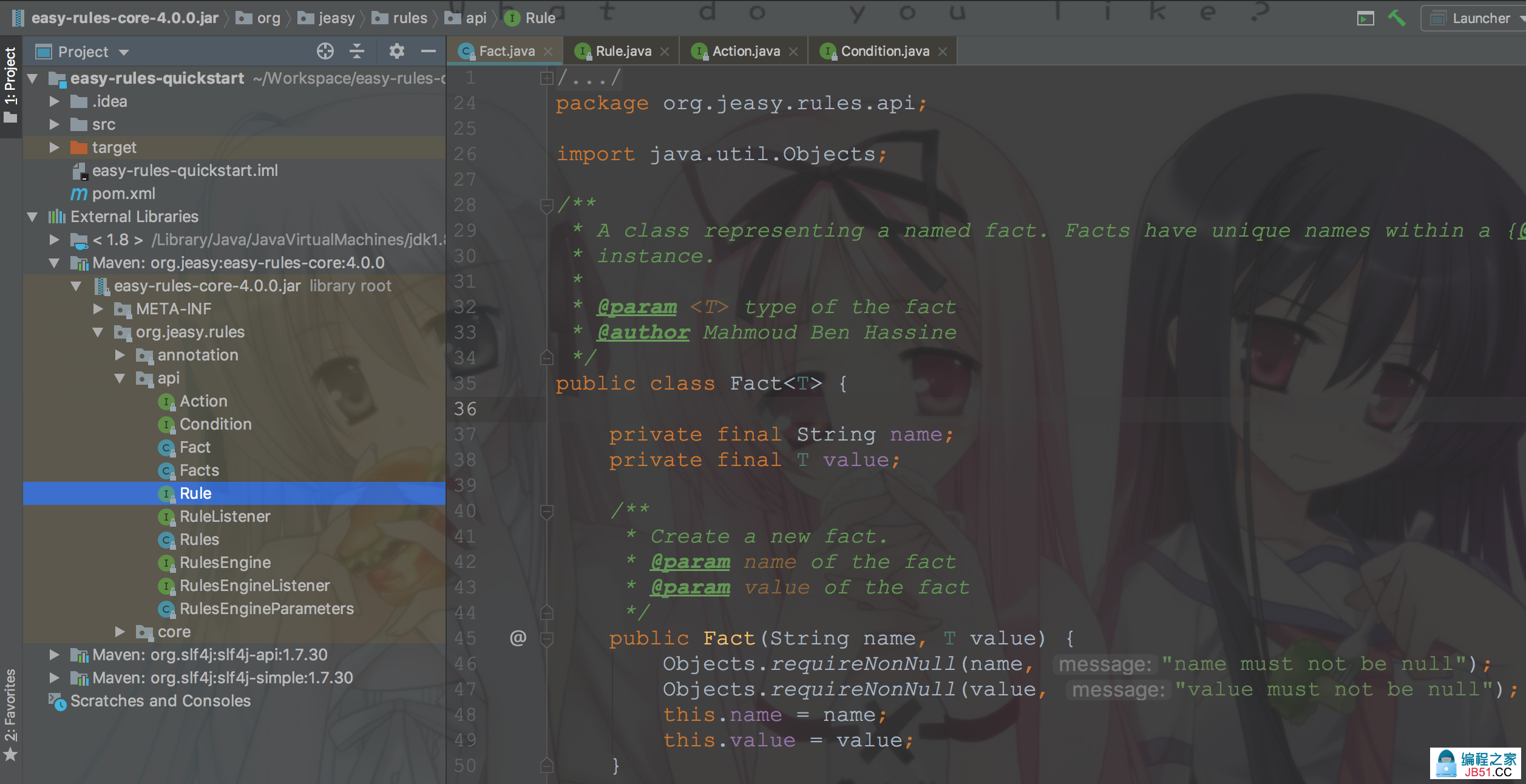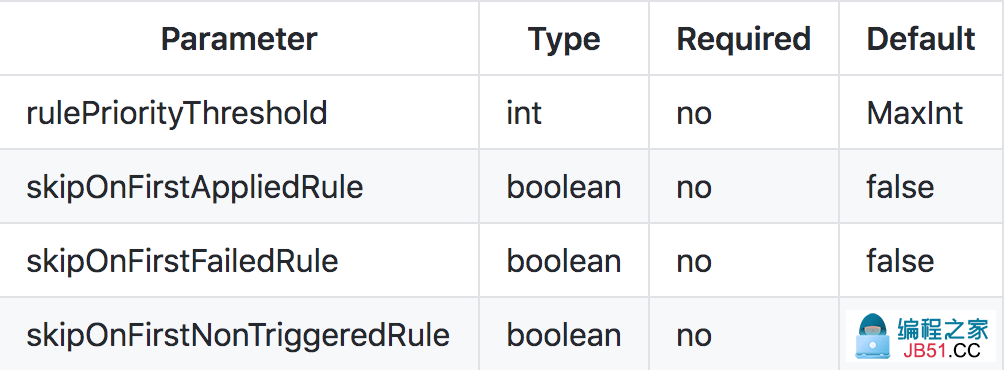1. Easy Rules 概述
Easy Rules是一个Java规则引擎,灵感来自一篇名为《Should I use a Rules Engine?》的文章
规则引擎就是提供一种可选的计算模型。与通常的命令式模型(由带有条件和循环的命令依次组成)不同,规则引擎基于生产规则系统。这是一组生产规则,每条规则都有一个条件(condition)和一个动作(action)———— 简单地说,可以将其看作是一组if-then语句。
精妙之处在于规则可以按任何顺序编写,引擎会决定何时使用对顺序有意义的任何方式来计算它们。考虑它的一个好方法是系统运行所有规则,选择条件成立的规则,然后执行相应的操作。这样做的好处是,很多问题都很自然地符合这个模型:
if car.owner.hasCellPhone then premium += 100; if car.model.theftRating > 4 then premium += 200if car.owner.livesInDodgyArea && car.model.theftRating > 2 then premium += 300;规则引擎是一种工具,它使得这种计算模型编程变得更容易。它可能是一个完整的开发环境,或者一个可以在传统平台上工作的框架。生产规则计算模型最适合仅解决一部分计算问题,因此规则引擎可以更好地嵌入到较大的系统中。
你可以自己构建一个简单的规则引擎。你所需要做的就是创建一组带有条件和动作的对象,将它们存储在一个集合中,然后遍历它们以评估条件并执行这些动作。
Easy Rules它提供Rule抽象以创建具有条件和动作的规则,并提供RuleEngine API,该API通过一组规则运行以评估条件并执行动作。
Easy Rules简单易用,只需两步:
首先,定义规则,方式有很多种
方式一:注解
@Rule(name = "weather rule",description = "if it rains then take an umbrella") public class WeatherRule { @Condition boolean itRains(@Fact("rain") boolean rain) { return rain; } @Action void takeAnUmbrella() { System.out.println("It rains,take an umbrella!"); } }
方式二:链式编程
Rule weatherRule = new RuleBuilder() .name("weather rule") .description("if it rains then take an umbrella") .when(facts -> facts.get("rain").equals(true)) .then(facts -> System.out.println("It rains,1)">)) .build();
方式三:表达式
Rule weatherRule = MVELRule() .name("weather rule") .when("rain == true") .then("System.out.println(\"It rains,take an umbrella!\");");
方式四:yml配置文件
例如:weather-rule.yml
name: "weather rule" description: "if it rains then take an umbrella" condition: "rain == true" actions: - "System.out.println(\"It rains,take an umbrella!\");"
MVELRuleFactory ruleFactory = new MVELRuleFactory( YamlRuleDefinitionReader()); Rule weatherRule = ruleFactory.createRule(new FileReader("weather-rule.yml"));
接下来,应用规则
Test { static main(String[] args) { // define facts Facts facts = Facts(); facts.put("rain",); define rules Rule weatherRule = ... Rules rules = Rules(); rules.register(weatherRule); fire rules on known facts RulesEngine rulesEngine = DefaultRulesEngine(); rulesEngine.fire(rules,facts); } }
入门案例:Hello Easy Rules
<dependency> groupId>org.jeasy</artifactId>easy-rules-coreversion>4.0.0> >
通过骨架创建maven项目:
mvn archetype:generate \ -DarchetypeGroupId=org.jeasy \ -DarchetypeArtifactId=easy-rules-archetype \ -DarchetypeVersion=4.0.0
默认给我们生成了一个HelloWorldRule规则,如下:
package com.cjs.example.rules; import org.jeasy.rules.annotation.Action; org.jeasy.rules.annotation.Condition; org.jeasy.rules.annotation.Rule; @Rule(name = "Hello World rule",description = "Always say hello world" HelloWorldRule { @Condition when() { return ; } @Action void then() throws Exception { System.out.println("hello world"); } }

2. 规则定义
2.1. 定义规则
大多数业务规则可以用以下定义表示:
- Name : 一个命名空间下的唯一的规则名称
- Description : 规则的简要描述
- Priority : 相对于其他规则的优先级
- Facts : 事实,可立即为要处理的数据
- Conditions : 为了应用规则而必须满足的一组条件
- Actions : 当条件满足时执行的一组动作
Easy Rules为每个关键点提供了一个抽象来定义业务规则。
在Easy Rules中,Rule接口代表规则
interface Rule { /** * This method encapsulates the rule's conditions. * @return true if the rule should be applied given the provided facts,false otherwise */ evaluate(Facts facts); * This method encapsulates the rule's actions. * @throws Exception if an error occurs during actions performing void execute(Facts facts) Exception; Getters and setters for rule name,description and priority omitted. }
evaluate方法封装了必须计算结果为TRUE才能触发规则的条件。execute方法封装了在满足规则条件时应该执行的动作。条件和操作由Condition和Action接口表示。
定义规则有两种方式:
- 通过在POJO类上添加注解
- 通过RuleBuilder API编程
可以在一个POJO类上添加@Rule注解,例如:
@Rule(name = "my rule",description = "my rule description",priority = 1 MyRule { @Condition boolean when(@Fact("fact") fact) { my rule conditions ; } @Action(order = 1) void then(Facts facts) Exception { my actions } @Action(order = 2void finally() my final actions } }
@Condition注解指定规则条件
@Fact注解指定参数
@Action注解指定规则执行的动作
RuleBuilder支持链式风格定义规则,例如:
Rule rule = RuleBuilder() .name("myRule") .description("myRuleDescription") .priority(3) .when(condition) .then(action1) .then(action2) .build();
组合规则
CompositeRule由一组规则组成。这是一个典型地组合设计模式的实现。
组合规则是一个抽象概念,因为可以以不同方式触发组合规则。
Easy Rules自带三种CompositeRule实现:
- UnitRuleGroup : 要么应用所有规则,要么不应用任何规则(AND逻辑)
- ActivationRuleGroup : 它触发第一个适用规则,并忽略组中的其他规则(XOR逻辑)
- ConditionalRuleGroup : 如果具有最高优先级的规则计算结果为true,则触发其余规则
复合规则可以从基本规则创建并注册为常规规则:
Create a composite rule from two primitive rules UnitRuleGroup myUnitRuleGroup = new UnitRuleGroup("myUnitRuleGroup","unit of myRule1 and myRule2"); myUnitRuleGroup.addRule(myRule1); myUnitRuleGroup.addRule(myRule2); Register the composite rule as a regular rule Rules rules = Rules(); rules.register(myUnitRuleGroup); RulesEngine rulesEngine = DefaultRulesEngine(); rulesEngine.fire(rules,someFacts);
每个规则都有优先级。它代表触发注册规则的默认顺序。默认情况下,较低的值表示较高的优先级。可以重写compareTo方法以提供自定义优先级策略。
2.2. 定义事实
在Easy Rules中,Fact API代表事实
class Fact<T> { private final String name; T value; }

举个栗子:
Fact<String> fact = new Fact("foo","bar"); Facts facts = Facts(); facts.add(fact);
或者,也可以用这样简写形式
Facts facts = Facts();
facts.put("foo","bar");
用@Fact注解可以将Facts注入到condition和action方法中
@Rule rain; } @Action takeAnUmbrella(Facts facts) { System.out.println("It rains,1)">); can add/remove/modify facts } }
2.3. 定义规则引擎
Easy Rules提供两种RulesEngine接口实现:
- DefaultRulesEngine : 根据规则的自然顺序应用规则
- InferenceRulesEngine : 持续对已知事实应用规则,直到不再适用任何规则为止
创建规则引擎:
RulesEngine rulesEngine = DefaultRulesEngine(); or RulesEngine rulesEngine = new InferenceRulesEngine();
然后,注册规则
rulesEngine.fire(rules,facts);
规则引擎有一些可配置的参数,如下图所示:

举个栗子:
RulesEngineParameters parameters = RulesEngineParameters() .rulePriorityThreshold(10) .skipOnFirstAppliedRule() .skipOnFirstFailedRule() .skipOnFirstNonTriggeredRule(); RulesEngine rulesEngine = new DefaultRulesEngine(parameters);
2.4. 定义规则监听器
通过实现RuleListener接口
RuleListener { * Triggered before the evaluation of a rule. * * @param rule being evaluated * facts known before evaluating the rule * true if the rule should be evaluated,false otherwise default beforeEvaluate(Rule rule,Facts facts) { ; } * Triggered after the evaluation of a rule. * * rule that has been evaluated * facts known after evaluating the rule * evaluationResult true if the rule evaluated to true,1)">void afterEvaluate(Rule rule,Facts facts,1)"> evaluationResult) { } * Triggered on condition evaluation error due to any runtime exception. * * facts known while evaluating the rule * exception that happened while attempting to evaluate the condition. onEvaluationError(Rule rule,Exception exception) { } * Triggered before the execution of a rule. * * rule the current rule * facts known facts before executing the rule beforeExecute(Rule rule,Facts facts) { } * Triggered after a rule has been executed successfully. * * facts known facts after executing the rule onSuccess(Rule rule,1)"> * Triggered after a rule has failed. * * facts known facts after executing the rule * exception the exception thrown when attempting to execute the rule onFailure(Rule rule,Exception exception) { } }
3. 示例
project xmlns="http://maven.apache.org/POM/4.0.0" xmlns:xsi="http://www.w3.org/2001/XMLSchema-instance" xsi:schemaLocation="http://maven.apache.org/POM/4.0.0 http://maven.apache.org/maven-v4_0_0.xsd"modelVersion>com.cjs.example>easy-rules-quickstart>1.0.0-SNAPSHOTpackaging>jardependencies> > >easy-rules-support>easy-rules-mvel>org.slf4j>slf4j-simple>1.7.30project>

4. 扩展
规则本质上是一个函数,如y=f(x1,x2,..,xn)
规则引擎就是为了解决业务代码和业务规则分离的引擎,是一种嵌入在应用程序中的组件,实现了将业务决策从应用程序代码中分离。
还有一种常见的方式是Java+Groovy来实现,Java内嵌Groovy脚本引擎进行业务规则剥离。
https://github.com/j-easy/easy-rules/wiki
版权声明:本文内容由互联网用户自发贡献,该文观点与技术仅代表作者本人。本站仅提供信息存储空间服务,不拥有所有权,不承担相关法律责任。如发现本站有涉嫌侵权/违法违规的内容, 请发送邮件至 dio@foxmail.com 举报,一经查实,本站将立刻删除。

